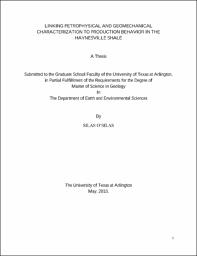
ATTENTION: The works hosted here are being migrated to a new repository that will consolidate resources, improve discoverability, and better show UTA's research impact on the global community. We will update authors as the migration progresses. Please see MavMatrix for more information.
Show simple item record
| dc.contributor.advisor | Wickham, John | |
| dc.creator | O'Silas, Silas | |
| dc.date.accessioned | 2019-08-29T20:49:31Z | |
| dc.date.available | 2019-08-29T20:49:31Z | |
| dc.date.created | 2018-08 | |
| dc.date.issued | 2018-08-08 | |
| dc.date.submitted | August 2018 | |
| dc.identifier.uri | http://hdl.handle.net/10106/28650 | |
| dc.description.abstract | In recent years, the Haynesville shale has become a target for natural gas exploitation, especially with the advent of horizontal drilling and hydraulic fracturing. Located in East Texas and Northwest Louisiana, it is believed to be one of the largest producing natural gas plays in the U.S., with estimated recoverable reserves of around 75 TCF according to the Energy Information Administration (EIA, 2011). Current total daily production for the entire play is around 5.4 Bcf/d. The economic potential of the Haynesville shale gas play is propelled by recent gradual rebounds in natural gas prices, increased industrial utilization of gas, and expansion of LNG export terminals along the gulf coast due to the lifting of the decades-old ban on exporting petroleum products.
Consequently, it is imperative to properly evaluate the petrophysical attributes of the shale in order to understand the reservoir characteristics that may ultimately influence production. This study focused on the petrophysical evaluation of wells in East Texas and Northwest Louisiana. Wireline logs and core data were integrated to provide a predictive template for targeting and landing lateral wellbores within the shale in order to provide useful insight for hydraulic fracture stimulation with the view of optimizing production. The critical factors determined to influence the target zones include geomechanical properties such as brittleness, and geochemical properties such as the mineral volumes in the rock. These were calculated from logs using equations previously published in literature and correlated to nearby core measurements for verification. Already drilled and completed laterals were also evaluated to identify potential refracturing opportunities that could remedy production decline. The stimulation techniques and production outcomes of these laterals were examined in an attempt to identify possible trends and contrasts accordingly.
The results show that the geomechanical properties vary across the shale play area. The geomechanical and geochemical properties can be useful in target selection for landing horizontal wells and effective fracture treatments, but they cannot by themselves guarantee productivity as other factors have to be taken into consideration such as completions method. The various operational constraints and development patterns such as different lateral lengths and age/style of completions make it difficult to do effective well-to-well production comparison; however the results points to trends such as longer lateral lengths with greater fracture stages to boost production. Additionally, in some areas, it has been established via the petrophysical analysis that there may be additional intervals in which to land a second horizontal well. This will surely lead to better exploitation and increased production from the reservoir. | |
| dc.format.mimetype | application/pdf | |
| dc.subject | Geology | |
| dc.subject | Petrophysics | |
| dc.subject | Geosteering | |
| dc.subject | Logs | |
| dc.subject | Shale | |
| dc.subject | Haynesville shale | |
| dc.title | LINKING PETROPHYSICAL AND GEOMECHANICAL CHARACTERIZATION TO PRODUCTION BEHAVIOR IN THE HAYNESVILLE SHALE | |
| dc.type | Thesis | |
| dc.degree.department | Earth and Environmental Sciences | |
| dc.degree.name | Master of Science in Earth and Environmental Science | |
| dc.date.updated | 2019-08-29T20:51:41Z | |
| thesis.degree.department | Earth and Environmental Sciences | |
| thesis.degree.grantor | The University of Texas at Arlington | |
| thesis.degree.level | Masters | |
| thesis.degree.name | Master of Science in Earth and Environmental Science | |
| dc.type.material | text | |
Files in this item
- Name:
- OSILAS-THESIS-2018.pdf
- Size:
- 4.469Mb
- Format:
- PDF
This item appears in the following Collection(s)
Show simple item record


